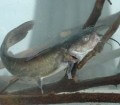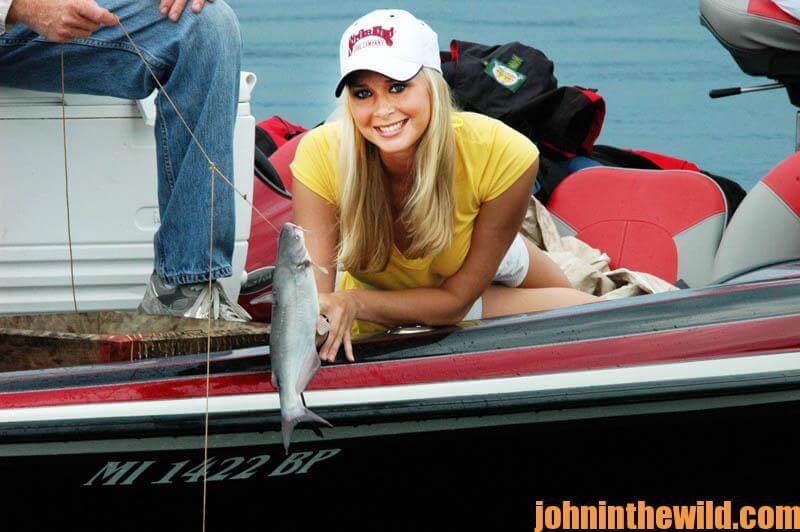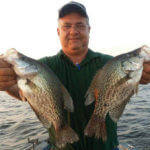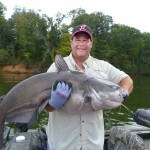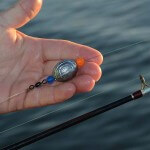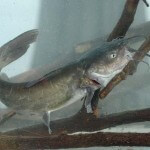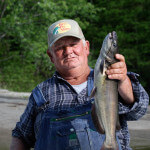Although some people use the word troutlining, in the South where I live, we call this type of catfishing, trotlining. Trotlining for cats is one of my favorite ways to fish. I’ve been fortunate to fish with some of the best trotliners in the nation.
Little Creeks:
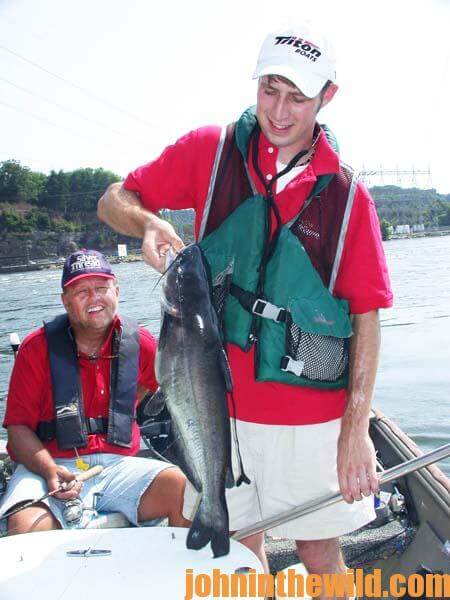 One of the masters of little-creek trotlining was Lem Walker of Eastaboga, Alabama, who caught 50 to 100 pounds of catfish almost any day we fished. Walker had several tactics that consistently produced flatheads, blues and channels. Walker fished from a small, aluminum johnboat. The creeks he fished often were no more than 30-yards wide. They were all close to our homes and overlooked by many catfish anglers. Walker would float down a creek and use a portable depth finder on the front end of his boat to look for bottom breaks, drop-offs, ledges and holes where he knew catfish fed. Once he found one of these spots, he would tie a piece of flagging tape onto a tree limb on the bank. Then he could find that place again the next day. Walker tried to pinpoint 5- to 10-deep holes or ledges along the creek he planned to fish before he fished it.
One of the masters of little-creek trotlining was Lem Walker of Eastaboga, Alabama, who caught 50 to 100 pounds of catfish almost any day we fished. Walker had several tactics that consistently produced flatheads, blues and channels. Walker fished from a small, aluminum johnboat. The creeks he fished often were no more than 30-yards wide. They were all close to our homes and overlooked by many catfish anglers. Walker would float down a creek and use a portable depth finder on the front end of his boat to look for bottom breaks, drop-offs, ledges and holes where he knew catfish fed. Once he found one of these spots, he would tie a piece of flagging tape onto a tree limb on the bank. Then he could find that place again the next day. Walker tried to pinpoint 5- to 10-deep holes or ledges along the creek he planned to fish before he fished it.
When Walker reached the take-out point on the creek where he had arranged for his wife to leave his car and trailer, he would take his boat out of the water, go by home, pick up his wife, his lines, his hooks and bait and start his run again. This time when Walker arrived at an area he had marked in the creek, he would tie braided cotton line to a tree root under the water and run the line across the river to the bank on the other side. Next he tied a rock anchor onto each end of the line about 10-feet out from each bank. Then he tied 1-foot drop lines to the main line. After attaching a barrel swivel onto each drop line, Walker tied about 8 inches of 30-pound test monofilament and a small hook to the second eye of each barrel swivel. He tied his drop lines about 18-inches apart onto each trotline which held 20 drop lines. Walker baited up with hellgrammites, live minnows, crawfish, catalpa worms, night crawlers, chicken livers, grasshoppers or whatever bait he felt would be appropriate for that time and place. Walker then spent the rest of the day putting out his lines and baiting them. The next morning he would run the creek to check his lines. What made Walker a master at small-creek trotlining was he looked for holes in the bottom. Then he placed his lines in the holes.
 Although catfish do move in a current, they basically are lazy. If they can sit in a hole and let their food be washed to them rather than having to fight the current to eat, that’s where the cats generally prefer to hold. However, most creek fishermen won’t go to the trouble of using a portable depth sounder to find the best spots in the creeks like Walker to put their trotlines. Walker also was a student of the woods and waters. He tried to match his bait to what the catfish naturally ate throughout each week of the season when he was fishing. If he noticed numbers of grasshoppers on the bank, he stopped and caught grasshoppers to use for bait. He believed some of those grasshoppers might have gotten into the water, and the cats might have fed on them. If he turned over rocks and found hellgrammites, he would use these little larvae for bait.
Although catfish do move in a current, they basically are lazy. If they can sit in a hole and let their food be washed to them rather than having to fight the current to eat, that’s where the cats generally prefer to hold. However, most creek fishermen won’t go to the trouble of using a portable depth sounder to find the best spots in the creeks like Walker to put their trotlines. Walker also was a student of the woods and waters. He tried to match his bait to what the catfish naturally ate throughout each week of the season when he was fishing. If he noticed numbers of grasshoppers on the bank, he stopped and caught grasshoppers to use for bait. He believed some of those grasshoppers might have gotten into the water, and the cats might have fed on them. If he turned over rocks and found hellgrammites, he would use these little larvae for bait.
Walker never bragged about his catch or showed his fish off to any other anglers. “Small streams can’t stand fishing pressure,” Walker told me once. “The more people who know you’re catching cats on a stream, the less cats you eventually will catch. I like to fish close to home. As long as no one knows where and how I’m fishing, I can continue to catch all the catfish I need for my family.”
Allen O’Dell’s Secret Trotlining Tactic:
Allen O’Dell of Clanton, Alabama, was a river trotline fisherman who habitually strung his lines across the mouths of creeks, from a riverbank out to the river channel and sometimes across river channels. But O’Dell never consistently could catch numbers of cats. O’Dell only might catch four or five catfish on a fishing trip. However, when the commercial fisherman who fished the same stream O’Dell did came to shore, he would have 50 to 75 catfish.
 Finally one day, O’Dell asked the commercial fisherman how and why he caught so many catfish. The commercial trotline fisherman looked at O’Dell, smiled and said, “I’m fishing where the cats are, and you’re fishing where they aren’t. At different times of the year, catfish prefer to feed and move at different water depths. If you know what depths the cats are feeding in, then you consistently can take catfish off each of your trotlines every day you run them.
Finally one day, O’Dell asked the commercial fisherman how and why he caught so many catfish. The commercial trotline fisherman looked at O’Dell, smiled and said, “I’m fishing where the cats are, and you’re fishing where they aren’t. At different times of the year, catfish prefer to feed and move at different water depths. If you know what depths the cats are feeding in, then you consistently can take catfish off each of your trotlines every day you run them.
“To find out what depths the cats are moving in, I put out four or five short lines in water depths from 5 to 30 feet. I also put out a line across the main river. I anchor this main river trotline with rocks in several places to be sure I have hooks in varying depths of water. Because of the varying depths on the bottom of a river, I take my depth finder with me the first time I run my big-river line. I note the depths where I catch the most cats on the river line. Then I check the short trotline that is in the same depth of water at another location on the river. Usually this short trotline will be loaded with cats, while the other short lines at other depths only have a few cats. Then the next day I’ll put all my short trotlines in the depths where I have caught the most fish to have the most lines in the depth of water where the most catfish are. Generally the cats will feed in that same depth for three to 10 days. But then they may move into more shallow or deeper water.
“To keep up with the exact depth the cats are feeding in, I run my big-river line every day with my depth finder. Then I have a constant report on what depth of water is producing the most cats. If the fish move from 30 feet to 25 feet, I move my short lines up to that 25-foot depth and continue to catch plenty of cats. A mistake many trotline fishermen make is to keep their lines at the same depth all spring and summer. If you’re not moving your lines and keeping up with the depth the cats are feeding in, you can’t catch catfish consistently.” When O’Dell tried this tactic, he drastically increased the number of cats he caught on every outing.
Throw-Line Trotlining:
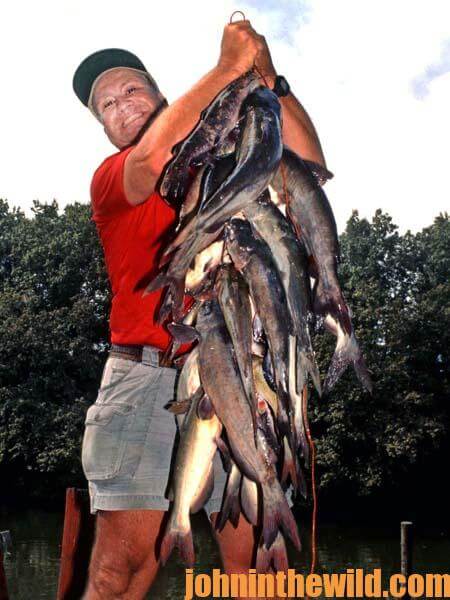 If you don’t have a boat, you still can trotline fish for cats from the bank by throw-line fishing. Tie a 3- or 4-pound rock on the end of a main line. Then attach five- to 10-drop line hooks coming off that main line. Bait those hooks for cats. After tying the other end of your line to a bush, a tree or a stump on the bank, throw the rock out into the creek or the river. The rock will carry the trotline, drop lines and hooks out into the waterway. When you want to check your line, pull it in, rebait, take the fish off the line, and throw it back out into the river or lake.
If you don’t have a boat, you still can trotline fish for cats from the bank by throw-line fishing. Tie a 3- or 4-pound rock on the end of a main line. Then attach five- to 10-drop line hooks coming off that main line. Bait those hooks for cats. After tying the other end of your line to a bush, a tree or a stump on the bank, throw the rock out into the creek or the river. The rock will carry the trotline, drop lines and hooks out into the waterway. When you want to check your line, pull it in, rebait, take the fish off the line, and throw it back out into the river or lake.
The key to taking more catfish may not be secret baits or super-complicated fishing techniques. The secret may be to first find an area that catfish frequent and concentrate most of your fishing in that region. These tactics have worked for others, and they will work for you.
John’s Note: Be sure to check your local fishing regulations before trotlining or jug fishing in any region. Some states may be restrictive of these techniques.
To get “13 Freshwater Fish Recipes You Can’t Live Without,” “Catfish Like a Pro,” “The Best Wild Game & Seafood Cookbook Ever: 350 Southern Recipes for Deer, Turkey, Fish, Seafood, Small Game and Birds,” click here. You can also get “The Catfish Catcher’s Cookbook” for free here.

